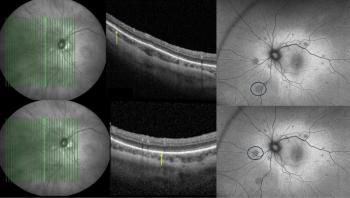
Novartis happy as Lucentis shows further promise in AMD
Novartis Ophthalmics' and Genentech's investigational treatment for AMD has again delighted its developers by meeting its one-year primary efficacy endpoint of maintaining vision in patients with wet AMD during the first year of the two-year ANCHOR study.
Novartis Ophthalmics' and Genentech's investigational treatment for AMD has again delighted its developers by meeting its one-year primary efficacy endpoint of maintaining vision in patients with wet AMD during the first year of the two-year ANCHOR study.
Preliminary data from the study found Lucentis (ranibizumab) maintained vision (defined as a loss of less than 15 letters in visual acuity) or improved vision in 94% and 96% of patients randomized to receive 0.3 mg or 0.5 mg of intravitreal Lucentis, respectively. Efficacy of the two doses was compared with that of the photodynamic therapy (PDT) Visudyne (verteporfin), which maintained vision in 64% of patients (p<0.0001) during the trial's first year.
Novartis Ophthalmics President, Nicholas Franco, is thrilled with the results, "Lucentis is the first drug ever to cause an improvement in vision in AMD patients - between 35 and 40% of patients have shown a significant improvement in vision. This is very exciting, both for us and for AMD patients."
The Phase III study is a randomized, multi-centre, double-masked, active-treatment controlled study designed to compare two doses of Lucentis versus PDT in 423 patients with predominantly classic wet AMD. Patients were randomized 1:1:1 to receive one of the two doses of Lucentis once a month or PDT every three months for two years. Visual acuity was ascertained using the Early Treatment of Diabetic Retinopathy (ETDRS) chart.
"It was amazing for me to see that the majority of patients could actually see better because of this treatment," said Professor Frank Holz, ANCHOR study lead investigator. "Personally, it has been incredible to witness the effect that the anti-VEGF treatment strategy has both on the permeability and the size of the choroidal neovascular lesions - leakage became less and the lesions became smaller throughout the treatment period," he enthused.
Lucentis prevents angiogenesis by inhibiting the protein VEGF-A, which is believed to play a critical role in new blood vessel growth and leakiness leading to wet AMD progression.
The Anti-VEGF Antibody for the Treatment of Predominantly Classic CHORoidal Neovascularization in AMD (ANCHOR) study further validated findings from the ongoing MARINA trial, preliminary data from which were presented at the 2005 ASRS meeting in Montréal, Canada.
The MARINA trial studied Lucentis in AMD versus sham, whereas ANCHOR is comparing the anti-VEGF treatment with Novartis' lead AMD therapy Visudyne. The anti-angiogenic was able to demonstrate superior efficacy in the ANCHOR trial. "We believe Lucentis and Visudyne have synergistic modes of action," said Franco. "While Lucentis treats choroidal neovascularization and hence prevents new vessel growth, it does not block blood flow through the newly formed vessels which contribute to the growth of the fibrovascular portion of the neovascular lesion. That's where Visudyne comes in - occluding vessels that are already there. So you have two very separate but complementary mechanisms of action and we are currently conducting trials which we anticipate will prove the benefit of this synergy," he revealed.
Common, yet mild to moderate, ocular adverse events reported during the study included conjunctival haemorrhage, eye pain, increased intraocular pressure and vitreous floaters. Uncommon serious ocular side effects such as endophthalmitis were observed in around 1% of patients. These adverse effects were more frequent in the treatment group receiving intravitreal injections than in the control group.
"As expected, there was no evidence of systemic side effects as a result of the low systemic exposure achieved with the intravitreal administration of Lucentis. One concern amongst retina specialists, however, will always be the risk of endophthalmitis. Fortunately, in both the MARINA and ANCHOR trials, rates of this worrying disease were extremely low," said Holz.
While its developers eagerly anticipate data submissions and the approval of their breakthrough treatment, many retina specialists have been administering the anti-VEGF treatment bevacizumab (Avastin) to their AMD patients. Approved for the treatment of metastatic colorectal cancer, bevacizumab is derived from the same parent antibody of Lucentis. Although the cancer treatment is being used off-label, has not been tested in AMD patients and the incidence of systemic side effects in this patient population are unknown, retina specialists who are using this therapy in practice are happy with the results so far.
Newsletter
Get the essential updates shaping the future of pharma manufacturing and compliance—subscribe today to Pharmaceutical Technology and never miss a breakthrough.













































